See All The #AnswerTime Questions Here: https://nasa.tumblr.com/tagged/answertime

The total solar eclipse is coming! Here’s your chance to ask an eclipse scientist your questions! Have questions about the upcoming total solar eclipse on August 21? Join our Tumblr Answer Time session on Thursday, August 17 from 3:00 – 4:00 p.m. EDT/12:00 - 1:00 p.m. PDT. here on NASA’s Tumblr, where space physics researcher Alexa Halford will answer them. Make sure to ask your questions now by visiting: https://nasa.tumblr.com/ask!
See all the #AnswerTime questions here: https://nasa.tumblr.com/tagged/answertime
Alexa Halford is a space physics researcher at our Goddard Space Flight Center and Dartmouth College. She started researching waves in Earth's magnetosphere as an undergraduate at Augsburg College with Mark Engebretson using ground based magnetometers in the Arctic and Antarctic. She moved away from waves to focus on geomagnetic storms and substorms during her masters at the University of Colorado Boulder with Dan Baker but returned once more to waves with her PhD at University of Newcastle NSW Australia. Her PhD thesis was on Electromagnetic Ion Cyclotron (EMIC) waves during the CRRES mission and their relationship to the plasmasphere and radiation belts.
She is member of the scientific team for a NASA-funded scientific balloon experiment project called BARREL (Balloon Array for RBSP Relativistic Electron Losses) where she looks at the population of particles lost due to these interactions. She is now currently a contractor at NASA Goddard continuing work the BARREL and NASA Van Allen Probes satellite missions.
To get more information about the eclipse, visit: https://eclipse2017.nasa.gov/
Make sure to follow us on Tumblr for your regular dose of space: http://nasa.tumblr.com
More Posts from Nasa and Others
Pluto Continues to Amaze

This dwarf planet sure knows how to get a BIG reaction because we’re stunned by the latest images from our New Horizons spacecraft!
Back on July 14, the spacecraft completed it’s historic Pluto flyby, and is now in an intensive downlink phase. During this time, New Horizons will send us some of the best data and images we’ve seen!
These latest images were taken just 15 minutes after New Horizons’ closest approach to Pluto. The spacecraft looked back toward the sun and captured this near-sunset view. Icy mountains, flat plains and the horizon can all be seen in detail.

When we take a closer look, these features truly begin to stand out. Mountains up to 11,000 feet high are met by flat icy plains that extend out to Pluto’s horizon. There, more than a dozen layers of haze in the dwarf planet’s atmosphere can be seen. It’s almost as if we’re flying over the surface with the New Horizons spacecraft.
Speaking of flyover, this new animation of Pluto has been created from images returned from the spacecraft this month. This view shows us what it might be like to take an aerial tour through Pluto’s thin atmosphere and soar above the surface.
These images and videos are not only stunning, but also provide us with important information about the dwarf planet. So far, scientists can tell that the weather changes from day to day on Pluto. These images, combined with others that have been downloaded, provide evidence for a remarkably Earth-like “hydrological” cycle on Pluto.
For updates on the data and images received by the New Horizons spacecraft, check our blog: https://blogs.nasa.gov/pluto/
Make sure to follow us on Tumblr for your regular dose of space: http://nasa.tumblr.com
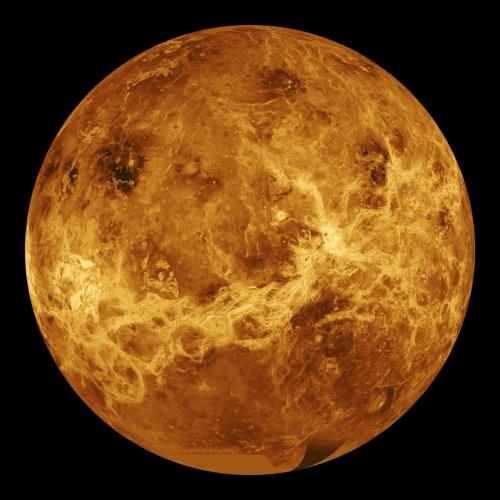
Exploring Hell... up for the challenge?
Venus is an EXTREME world, and we’re calling on YOU to help us explore it! NASA Jet Propulsion Laboratory is running a public challenge to develop an obstacle avoidance sensor for a possible future Venus rover.
With a surface temperature in excess of 840 degrees Fahrenheit and a surface pressure 92 times that of Earth, Venus can turn lead into a puddle and crush a nuclear-powered submarine with ease. While many missions have visited our sister planet, only about a dozen have made contact with the surface of Venus before succumbing to the oppressive heat and pressure after just about more than an hour.
The “Exploring Hell: Avoiding Obstacles on a Clockwork Rover” challenge is seeking the public’s designs for a sensor that could be incorporated into the design concept. The winning sensor could be the primary mechanism by which the rover detects and navigates around obstructions.
Award: 1st Place - $15,000; 2nd Place - $10,000; 3rd Place - $5,000
Open Date: February 18, 2020 ––––––––– Close Date: May 29, 2020
Magnetospheres: How Do They Work?
The sun, Earth, and many other planets are surrounded by giant magnetic bubbles.

Space may seem empty, but it’s actually a dynamic place, dominated by invisible forces, including those created by magnetic fields. Magnetospheres – the areas around planets and stars dominated by their magnetic fields – are found throughout our solar system. They deflect high-energy, charged particles called cosmic rays that are mostly spewed out by the sun, but can also come from interstellar space. Along with atmospheres, they help protect the planets’ surfaces from this harmful radiation.
It’s possible that Earth’s protective magnetosphere was essential for the development of conditions friendly to life, so finding magnetospheres around other planets is a big step toward determining if they could support life.
But not all magnetospheres are created equal – even in our own backyard, not all planets in our solar system have a magnetic field, and the ones we have observed are all surprisingly different.

Earth’s magnetosphere is created by the constantly moving molten metal inside Earth. This invisible “force field” around our planet has an ice cream cone-like shape, with a rounded front and a long, trailing tail that faces away from the sun. The magnetosphere is shaped that way because of the constant pressure from the solar wind and magnetic fields on the sun-facing side.

Earth’s magnetosphere deflects most charged particles away from our planet – but some do become trapped in the magnetic field and create auroras when they rain down into the atmosphere.

We have several missions that study Earth’s magnetosphere – including the Magnetospheric Multiscale mission, Van Allen Probes, and Time History of Events and Macroscale Interactions during Substorms (also known as THEMIS) – along with a host of other satellites that study other aspects of the sun-Earth connection.


Mercury, with a substantial iron-rich core, has a magnetic field that is only about 1% as strong as Earth’s. It is thought that the planet’s magnetosphere is stifled by the intense solar wind, limiting its strength, although even without this effect, it still would not be as strong as Earth’s. The MESSENGER satellite orbited Mercury from 2011 to 2015, helping us understand our tiny terrestrial neighbor.


After the sun, Jupiter has by far the biggest magnetosphere in our solar system – it stretches about 12 million miles from east to west, almost 15 times the width of the sun. (Earth’s, on the other hand, could easily fit inside the sun.) Jupiter does not have a molten metal core like Earth; instead, its magnetic field is created by a core of compressed liquid metallic hydrogen.

One of Jupiter’s moons, Io, has intense volcanic activity that spews particles into Jupiter’s magnetosphere. These particles create intense radiation belts and the large auroras around Jupiter’s poles.

Ganymede, Jupiter’s largest moon, also has its own magnetic field and magnetosphere – making it the only moon with one. Its weak field, nestled in Jupiter’s enormous shell, scarcely ruffles the planet’s magnetic field.
Our Juno mission orbits inside the Jovian magnetosphere sending back observations so we can better understand this region. Previous observations have been received from Pioneers 10 and 11, Voyagers 1 and 2, Ulysses, Galileo and Cassini in their flybys and orbits around Jupiter.

Saturn’s moon Enceladus transforms the shape of its magnetosphere. Active geysers on the moon’s south pole eject oxygen and water molecules into the space around the planet. These particles, much like Io’s volcanic emissions at Jupiter, generate the auroras around the planet’s poles. Our Cassini mission studies Saturn’s magnetic field and auroras, as well as its moon Enceladus.


Uranus’ magnetosphere wasn't discovered until 1986 when data from Voyager 2’s flyby revealed weak, variable radio emissions. Uranus’ magnetic field and rotation axis are out of alignment by 59 degrees, unlike Earth’s, whose magnetic field and rotation axis differ by only 11 degrees. On top of that, the magnetic field axis does not go through the center of the planet, so the strength of the magnetic field varies dramatically across the surface. This misalignment also means that Uranus’ magnetotail – the part of the magnetosphere that trails away from the sun – is twisted into a long corkscrew.


Neptune’s magnetosphere is also tilted from its rotation axis, but only by 47. Just like on Uranus, Neptune’s magnetic field strength varies across the planet. This also means that auroras can be seen away from the planet’s poles – not just at high latitudes, like on Earth, Jupiter and Saturn.

Does Every Planet Have a Magnetosphere?
Neither Venus nor Mars have global magnetic fields, although the interaction of the solar wind with their atmospheres does produce what scientists call an “induced magnetosphere.” Around these planets, the atmosphere deflects the solar wind particles, causing the solar wind’s magnetic field to wrap around the planet in a shape similar to Earth’s magnetosphere.

What About Beyond Our Solar System?
Outside of our solar system, auroras, which indicate the presence of a magnetosphere, have been spotted on brown dwarfs – objects that are bigger than planets but smaller than stars.
There’s also evidence to suggest that some giant exoplanets have magnetospheres. As scientists now believe that Earth’s protective magnetosphere was essential for the development of conditions friendly to life, finding magnetospheres around exoplanets is a big step in finding habitable worlds.
Make sure to follow us on Tumblr for your regular dose of space: http://nasa.tumblr.com
Craving some summer Sun? We're inviting people around the world to submit their names to be placed on a microchip that will travel to the Sun aboard Parker Solar Probe!
Launching summer 2018, Parker Solar Probe will be our first mission to "touch" a star. The spacecraft - about the size of a small car - will travel right through the Sun's atmosphere, facing brutal temperatures and radiation as it traces how energy and heat move through the solar corona and explores what accelerates the solar wind and solar energetic particles.
Send your name along for the ride at go.nasa.gov/HotTicket! Submissions will be accepted through April 27, 2018.
Make sure to follow us on Tumblr for your regular dose of space: http://nasa.tumblr.com.
Space Gardening 101
You can’t escape eating (or gardening!) your vegetables, even if you’re in space. On Aug. 10, astronauts on the International Space Station sampled their first space grown salad. This freshly harvest red romaine lettuce was grown in the “Veggie” plant growth chamber that is designed to make gardens flourish in weightlessness.
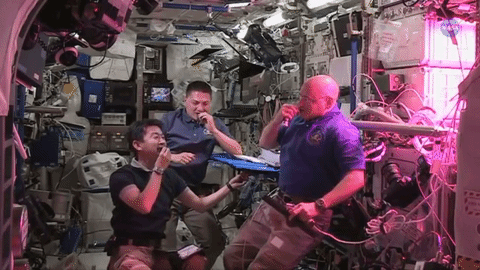
In a weightless environment, there is no up and down, so roots grow in all directions. Water and soil, the materials used to anchor these plants and allow for root growth tend to float away.
How Do We Grow Plants in Space?
1. Plant Pillows
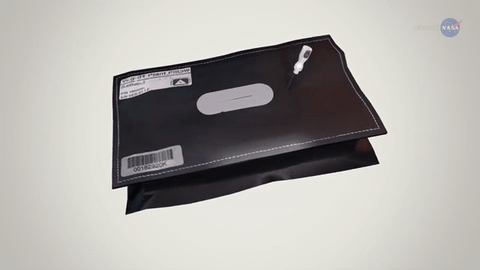
The Veggie chamber helps solve the problems of a weightless environment by using ‘plant pillows’, sounds comfy right? These pillows are bags filled with material for growing plants in space.
2. Wicks

Wicks are implanted into the bags and are used to draw water from inside the pillow to the plant.
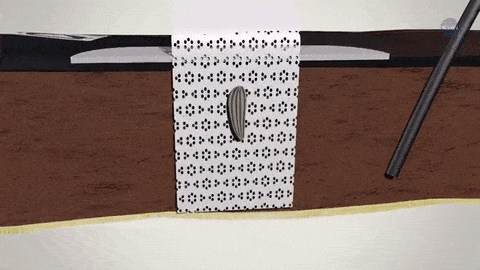
These wicks also provide a place to glue the seeds. It’s important to orient the seeds so roots will grow ‘down’, and shoots that emerge will push out of the bag.
3. LED Lights
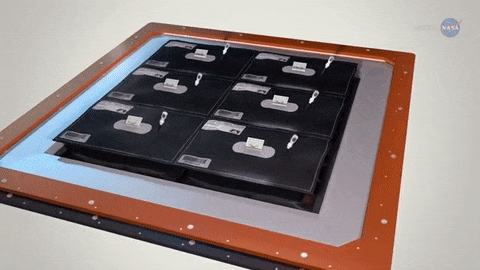
LED lights are used for photosynthesis and give the shoots a sense of direction so they keep growing upward. The walls of the Veggie chamber can expand to make room for the plant as it grows.
The purple/pinkish hue surrounding the plants in Veggie is the result of a combination of the red and blue lights, which is what the plants need to grow. Green LEDS were added so the plants look like edible food rather than weird purple plants.
Why are we growing plants in space?
When astronauts travel on deep space missions, like Mars, they will need to be self-sufficient for long periods of time. Having the ability to grow their own food is a big step in that direction. There is also a desire to grow flowering vegetables in space, which is why we are currently tending to zinnia flowers on orbit. Growing these flowering plants will help us understand longer duration growing plants that have to flower in space, such as tomatoes.
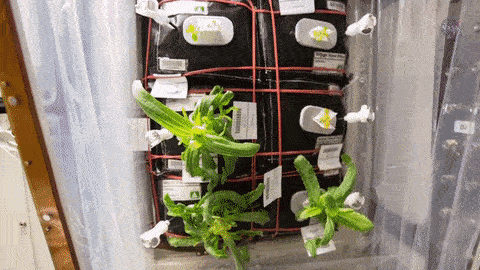
What’s Next? The next SpaceX delivery will include seeds for a small cabbage and additional red romaine lettuce. Upcoming experiments will use various ratios of red and blue lights and different fertilizers in attempts to improve crop yield, nutrition and flavor. The findings from these experiments can be utilized both on Earth and in space.
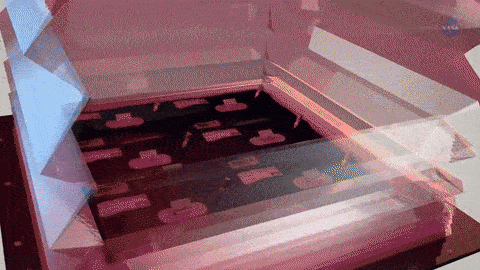
In addition to the nutrition benefits of growing vegetables in space, the psychological benefits are also significant. Having living plants can help with stress and increase the crews’ enjoyment. It provides the sights, smells and tastes of Earth.
To learn more about gardening in space, watch ScienceCast HERE.
Make sure to follow us on Tumblr for your regular dose of space: http://nasa.tumblr.com
Solar System: Things to Know This Week
10 Tools for the Armchair Astronaut, or How to Explore the Solar System from Home
At this very moment, spacecraft are surveying the solar system, from Mars, to Saturn, to Pluto and beyond. Now you can ride along to see the latest discoveries from deep space. For this week's edition of 10 Things, we've assembled a toolkit of 10 essential resources for the desktop astronaut.

1. It's Like Facebook, but for Planets
Or is it more of a Hitchhiker's Guide to the Solar System? Whatever one calls it, our planets page offers quick rundowns, as well as in-depth guides, for all the major bodies in the solar system. Explore from the sun all the way to the Oort Cloud.
+ Peruse the planets + See how objects in the solar system stack up against each other

2. Keep Your Eyes on This One
If you still haven't tried Eyes on the Solar System, you're missing out. This free, downloadable simulation app lets you tour the planets and track the past, current and future positions of spacecraft--all in 3D. Eyes on the Solar System uses real NASA data to help you take a virtual flight across both space and time.
+ Prepare for departure

3. Dateline: Deep Space
With so much exploration underway, discoveries and new insights into the solar system come at a pace that borders on bewildering. NASA is rewriting the textbooks, literally, on a regular basis. Relax, though: there are several easy ways to stay up to date with what's happening in space.
+ See the latest headlines + Stay connected on social media: Twitter, Facebook, Instagram + Find more top NASA social media accounts

4. Space? There's an App for That
NASA offers phone and tablet apps for star gazing, pictures, news, 3D tours, satellite tracking, live NASA TV and many other kinds of info.
+ Start downloading + See other cool apps

5. A (Very) Long Distance Call
We’re in constant communication with spacecraft all over the solar system. The Deep Space Network is a global network of giant antenna dishes that makes it possible. With this online app, you can learn how it works -- and even see which spacecraft are phoning home right now.
+ Deep Space Network (DSN) Now

6. Collect 'Em All
Spacecraft 3D is an augmented reality (AR) application that lets you learn about and interact with a variety of spacecraft that are used to explore our solar system, study Earth and observe the universe. Print out the AR target and your camera will do the rest, making the spacecraft appear in 3D right in front of you. Learn more about these robotic explorers as they pop up on your desk, in your hand, or on your dog's head.
+ Download Spacecraft 3D + See more cool 3-D resources from NASA

7. Ever Wanted to Drive a Mars Rover?
This site will give you a 3D look at the Mars Curiosity rover, along with some of the terrain it has explored. It will even let you take the controls.
+ Experience Curiosity

8. More E-Ticket Attractions
But wait, there's more. NASA offers a variety of other fascinating (and free) online experiences, all based on actual data from real missions. Here are a few to explore:
+ Mars Trek + Vesta Trek + Moon Trek

9. The Universe Is Our Classroom
Studying the solar system makes for a compelling route into learning and teaching science, engineering and math. We have some great places to start.
+ Find resources for teachers + Build your own solar system with your classroom

10. Bring It on Home
After you've toured the far reaches of the solar system, you can always come home again. When you have spent time studying the harsh conditions on our neighboring planets, the charms of a unique paradise come into sharp focus, the place we call Earth.
+ Watch a real-time video feed from Earth orbit + See a daily global view of our planet from a million miles away + Hold the earth in your hands with the Earth Now mobile app
Discover more lists of 10 things to know about our solar system HERE.
Follow us on Tumblr for your regular dose of space: http://nasa.tumblr.com
The California Wildfires from Above
As massive wildfires continue to rage in southern California, our satellites, people in space and aircraft are keeping an eye on the blazes from above.
This data and imagery not only gives us a better view of the activity, but also helps first responders plan their course of action.

A prolonged spell of dry weather primed the area for major fires. The largest of the blazes – the fast-moving Thomas fire in Ventura County – charred more than 65,000 acres.

Powerful Santa Ana winds fanned the flames and forecasters with the LA office of the National Weather Service warned that the region is in the midst of its strongest and longest Santa Ana wind event of the year.
These winds are hot, dry and ferocious. They can whip a small brush fire into a raging inferno in just hours.

Our Aqua satellite captured the above natural-color image on Dec. 5. Actively burning areas are outlined in red. Each hot spot is an area where the thermal detectors on the satellite recognized temperatures higher than the background.

On the same day, the European Space Agency’s Sentinel-2 satellite captured the data for the above false-color image of the burn scar. This image uses observations of visible, shortwave infrared and near infrared light.

From the vantage point of space, our satellites and astronauts are able to see a more comprehensive view of the activity happening on the ground.

The crew living and working 250 miles above Earth on the International Space Station passed over the fires on Dec. 6. The above view was taken by astronaut Randy Bresnik as the station passed over southern California.

During an engineering flight test of our Cloud-Aerosol Multi-Angle Lidar (CAMAL) instrument, a view from our ER-2 high-altitude research aircraft shows smoke plumes. From this vantage point at roughly 65,000 feet, the Thomas Fire was seen as it burned on Dec. 5.

Our satellites can even gather data and imagery of these wildfires at night. The above image on the right shows a nighttime view of the fires on Dec. 5.
For comparison, the image on the left shows what this region looked like the day before. Both images were taken by the Suomi NPP satellite, which saw the fires by using a special “day-night band” to detect light in a range of wavelengths from green to near-infrared and uses light intensification to detect dim signals.

Having the capability to see natural disasters, like these wildfires in southern California, provides first responders with valuable information that helps guide their action in the field.
For more wildfire updates, visit: nasa.gov/fires.
Make sure to follow us on Tumblr for your regular dose of space: http://nasa.tumblr.com.
6 Tiny Satellites That Are Changing How We See Earth

HARP: Hyper-Angular Rainbow Polarimeter
What’s better than taking a picture of a cloud to figure out its size and shape? Taking a bunch of pictures all around it. That way you get a three-dimensional view without having to worry about missing something. The HARP CubeSat is going to do just that: make observations of cloud droplets and tiny airborne particles like soot and dust with a modified camera lens from multiple angles. This will give us a full rendering of what’s going on inside the clouds, specifically, how those airborne particles act as “seeds” for water vapor to condense on and form cloud droplets. Since so many of those particles are in the air as a result of man-made pollution, we want to understand how they may be affecting clouds, weather and climate.

RAVAN: Radiometer Assessment using Vertically Aligned Nanotubes
Anyone who’s worn a black shirt on a summer day knows how much sunlight and heat it absorbs. The RAVAN 3-unit CubeSat, however, carries “blacker than black” technology – carbon nanotubes set up like a bundle of drinking straws that suck up nearly all the sunlight and energy that reach them to the point that your black shirt seems merely dark grey in comparison. Flying in low Earth orbit, RAVAN’s super sensitive instrument will detect tiny changes in the amount of sunlight and energy passing into and out of the top of the atmosphere. The amount of energy passing through the top of the atmosphere is where the net accounting of Earth’s energy budget happens – one of the major measurements we need in order to understand the effects of greenhouse gases on global warming and climate change.

MiRaTA: Microwave Radiometer Technology Acceleration
That long skinny piece coming out of the bottom right side under the solar panel? That’s a measuring tape. It’s doubling as a communications antenna on the MiRaTA CubeSat that will be a mini-weather station in space. This 3-unit, shoe box-sized satellite is testing out new, miniaturized technology to measure temperature, water vapor, and cloud ice in the atmosphere. They’ll be tracking major storms, including hurricanes, as well as everyday weather. If this test flight is successful, the new, smaller technology will likely be incorporated into major – large – weather satellite missions in the future that are part of our national infrastructure.

IceCube
The aptly named IceCube will measure – you guessed it – ice in our atmosphere. Unlike the droplets that make up rain, ice is one of the harder things to measure from space. IceCube is a 3-unit CubeSat about the size of a loaf of bread outfitted with a new high-frequency microwave radiometer, an instrument that measures naturally occurring radiation emitted by stuff in the atmosphere – cloud droplets, rain, and the ice particles at the tops of clouds. This will be the first space test of the new microwave radiometer that has to balance its tiny size and low power with being sensitive enough to detect cloud ice.

CYGNSS: Cyclone, Global Navigation Satellite System
What do GPS signals do when they’re not talking to your phone? A lot of them are just bouncing harmlessly off the planet’s surface – a fact that the CYGNSS mission is taking advantage of to measure wind speed over the ocean. Eight identical small satellites, each about the size of a microwave oven, flying in formation carry custom modified GPS receivers pointed at the oceans. When the water is smooth – not windy – the GPS signals reflect back uniformly, like the moon on a pond reflected as if in a mirror. When the water is choppy – windy – the signals reflect back in in the same direction but distorted, like the moon reflection on a choppy pond being distorted by ripples. Flying eight satellites in formation means the CYGNSS mission can measure wind speed across more of the ocean at once, which will help with understanding tropical storms and hurricanes.

TROPICS: Time-Resolved Observations of Precipitation structure and storm Intensity with a Constellation of Smallsats
An important way to improve forecasts of hurricane and tropical cyclone intensity is to see what’s going on inside and around them while they’re happening. That’s the goal of the TROPICS mission, 12 CubeSats that will fly in formation to track the temperature and humidity of storm environments. The TROPICS CubeSats will get very frequent measurements, similar to X-rays, that cut through the overall cloud-cover so we can see the storm’s underlying structure. The storm structures known as the eyewall – tall clouds, wind and rain around the eye – and rainbands – the rainy parts of the spiral arms – give us clues about whether a storm is primed to intensify into a category 4 or 5 storm, something everyone in their path needs to know.
Learn more the world of small satellites at: https://www.nasa.gov/mission_pages/smallsats
Make sure to follow us on Tumblr for your regular dose of space: http://nasa.tumblr.com
Get Ready To Launch America!

A new era of human spaceflight is about to begin. American astronauts will once again launch on an American rocket from American soil to the International Space Station as part of our Commercial Crew Program! NASA astronauts Bob Behnken and Doug Hurley will fly on SpaceX’s Crew Dragon spacecraft, lifting off on a Falcon 9 rocket at 4:32 p.m. EDT May 27, from Kennedy Space Center in Florida, for an extended stay at the space station for the Demo-2 mission.

As the final flight test for SpaceX, this mission will validate the company’s crew transportation system, including the launch pad, rocket, spacecraft and operational capabilities. This also will be the first time NASA astronauts will test the spacecraft systems in orbit.

Behnken and Hurley were among the first astronauts to begin working and training on SpaceX’s next-generation human space vehicle and were selected for their extensive test pilot and flight experience, including several missions on the space shuttle.

Behnken will be the joint operations commander for the mission, responsible for activities such as rendezvous, docking and undocking, as well as Demo-2 activities while the spacecraft is docked to the space station.

Hurley will be the spacecraft commander for Demo-2, responsible for activities such as launch, landing and recovery.

Lifting off from Launch Pad 39A atop a specially instrumented Falcon 9 rocket, Crew Dragon will accelerate its two passengers to approximately 17,000 mph and put it on an intercept course with the International Space Station. In about 24 hours, Crew Dragon will be in position to rendezvous and dock with the space station. The spacecraft is designed to do this autonomously but astronauts aboard the spacecraft and the station will be diligently monitoring approach and docking and can take control of the spacecraft if necessary.

The Demo-2 mission will be the final major step before our Commercial Crew Program certifies Crew Dragon for operational, long-duration missions to the space station. This certification and regular operation of Crew Dragon will enable NASA to continue the important research and technology investigations taking place onboard the station, which benefits people on Earth and lays the groundwork for future exploration of the Moon and Mars starting with the agency’s Artemis program, which will land the first woman and the next man on the lunar surface in 2024.
Get excited and follow along on social media using the hashtag #LaunchAmerica!
Make sure to follow us on Tumblr for your regular dose of space: http://nasa.tumblr.com.
As astronauts, do you have control over which experiments you conduct aboard the ISS? Which ones have been your personal favorites?
-
 sk8echo liked this · 1 year ago
sk8echo liked this · 1 year ago -
 transparentsoulfox liked this · 1 year ago
transparentsoulfox liked this · 1 year ago -
 john-erby liked this · 3 years ago
john-erby liked this · 3 years ago -
 mortenone liked this · 3 years ago
mortenone liked this · 3 years ago -
 2reputationpegacorns liked this · 3 years ago
2reputationpegacorns liked this · 3 years ago -
 catpeaks reblogged this · 4 years ago
catpeaks reblogged this · 4 years ago -
 catpeaks liked this · 4 years ago
catpeaks liked this · 4 years ago -
 the-shooting-star liked this · 4 years ago
the-shooting-star liked this · 4 years ago -
 oscar-silva-g liked this · 4 years ago
oscar-silva-g liked this · 4 years ago -
 bethelnie-blog liked this · 5 years ago
bethelnie-blog liked this · 5 years ago -
 jjrice2233 liked this · 5 years ago
jjrice2233 liked this · 5 years ago -
 dr-workout liked this · 5 years ago
dr-workout liked this · 5 years ago -
 automaticskeletoncopnickel-blog liked this · 5 years ago
automaticskeletoncopnickel-blog liked this · 5 years ago -
 hotgmcars liked this · 5 years ago
hotgmcars liked this · 5 years ago -
 haliphron liked this · 5 years ago
haliphron liked this · 5 years ago -
 batjohnsmithme liked this · 5 years ago
batjohnsmithme liked this · 5 years ago -
 kevinsvibe liked this · 5 years ago
kevinsvibe liked this · 5 years ago -
 thnks-fr-th-samulet liked this · 5 years ago
thnks-fr-th-samulet liked this · 5 years ago -
 lucmarcou liked this · 5 years ago
lucmarcou liked this · 5 years ago -
 themarionettewashere liked this · 5 years ago
themarionettewashere liked this · 5 years ago -
 groochi-gang liked this · 5 years ago
groochi-gang liked this · 5 years ago -
 mandylee70 liked this · 5 years ago
mandylee70 liked this · 5 years ago -
 wounded-souls-and-cigarettes reblogged this · 5 years ago
wounded-souls-and-cigarettes reblogged this · 5 years ago -
 auntiedonna101 liked this · 5 years ago
auntiedonna101 liked this · 5 years ago -
 saltytrashman-blog liked this · 5 years ago
saltytrashman-blog liked this · 5 years ago
Explore the universe and discover our home planet with the official NASA Tumblr account
1K posts